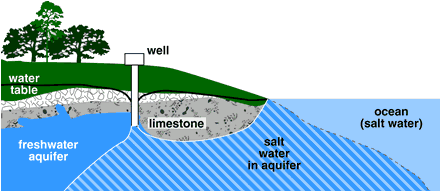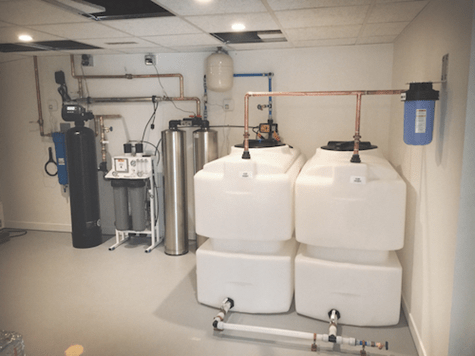Salt Water Intrusion in Wells
Salt water intrusion occurs in coastal freshwater aquifers when the different freshwater and salt water densities allow the intrusion of ocean water into the freshwater aquifer. These areas typically support populations where the groundwater demand from these aquifers exceeds the recharge or replenishment rate of fresh water. This can become more likely when the water is being used for in-house use as well as lawn irrigation. Irrigating with salty water will destroy grass, trees, and plants.

Aquifers are naturally replenished by precipitation and surface waters that saturate into the ground and work their way through the soil, rocks, etc. to the water table. The encroaching seawater will encounter an area known as the zone of dispersion, where the freshwater and saltwater mix. This interface moves back and forth naturally because of fluctuations in the recharge rate of freshwater back into the aquifer. The illustration above shows what this salt water intrusion looks like underground.

Whole Home Reverse Osmosis Filtration System
Where Saltwater Intrusion Occurs
There are many homes with private wells near coastal areas where there is no access to public water supplies because of distance to the water distribution system or other reasons. When the well experiences salt water intrusion, the proven and tested technology to desalinate the water is reverse osmosis, a membrane technology that was invented in the 1950s specifically for sea water desalination. A system designed to treat the water at the point of entry into the home will correct this salt water intrusion. A complete water test and analysis will determine the required pre-treatment prior to the reverse osmosis membrane depending on other mineral levels in the water. For example, iron, manganese and hardness minerals may be present and need to be removed. Also, determining estimated water usage is important for sizing the membrane, pre-treatment and storage capacity required. For more on salt water intrusion, see the link at https: //www.usgs.gov/mission-areas/water-resources/science/saltwater-intrusion
If you have noticed salty taste, heavy corrosion, or a salty build-up on dishware or fixtures, contact us to discuss options, costs involved, etc.
